By
Eric Vandenbroeck and co-workers
Göbekli Tepe revisited
part three
Of the world’s significant Neolithic expansions
took place in island Oceania. Its origins lay at the other end of Asia, in the
rice- and millet-growing cultures of Taiwan and the Philippines (the deeper
roots are in China). Around 1600 BC, a striking dispersal of farming groups
occurred, starting here and ending over 5,000 miles to the east in Polynesia.
Local seed crops were cultivated by 3000
BC, but there was no ‘serious farming’ until around AD 1000. China follows a
similar pattern. Millet farming began on a small scale around 8000 BC as a
seasonal complement to foraging and dog-assisted hunting. It remained so for
3,000 years until the introduction of cultivated millets into the basin of the
Yellow River. Similarly, on the lower and middle reaches of the Yangtze, fully
domesticated rice strains only appeared fifteen centuries after the first
cultivation of wild rice. It might have taken longer were it not for a snap of
global cooling around 5000 BC, which depleted wild rice stands and nut
harvests.1 In both parts of China, pigs still came second to wild boar and deer
in terms of dietary significance long after their domestication.
But the scale of pre-Columbian capitals
like Teotihuacan or Tenochtitlan dwarfs that of the earliest cities in China
and Mesopotamia. It makes the ‘city-states’ of Bronze Age Greece (like Tiryns
and Mycenae) seem little more than fortified hamlets.
We now know that in China’s Shandong
province, on the lower reaches of the Yellow River, settlements of 300 hectares
or more were present by no later than 2500 BC, which is over 1,000 years before
the earliest royal dynasties developed on the Central Chinese plains. On the
other side of the Pacific, around the same time, ceremonial centers of great
magnitude developed in the valley of Peru’s Rio Supe, notably at Caral.2 The
extent of human habitation around these great centers is still to be
determined. These new findings show that archaeologists still have much to find
out about the distribution of the world’s first cities. They also indicate how
much older those cities may be than the systems of authoritarian government and
literate administration that were once assumed necessary for their foundation.
When historians, philosophers, or
political scientists argue about the origin of the state in ancient Peru or
China, what they are doing is projecting that a rather unusual constellation of
elements backward: typically, by trying to find a moment when something like
sovereign power came together with something like an administrative system (the
competitive political field is usually considered somewhat optional). What
interests them is precisely how and why these elements came together in the
first place. For instance, a classic story of human political evolution told by
earlier scholars was that states arose from the need to manage complex
irrigation systems, or perhaps just large concentrations of people and
information. This gave rise to top-down power, which eventually came to be
tempered by democratic institutions.
That would imply a sequence of
development somewhat like this:
![]()
Evidence from ancient Eurasia now points
to a different pattern, where urban administrative systems inspire a cultural
counter-reaction (a further example of schismogenesis), in the form of squabbling highland
princedoms (‘barbarians,’ from the perspective of the city dwellers),3 which
eventually leads to some of those princes establishing themselves in cities and
systematizing their power:

This may well have happened in some
cases, but it seems unlikely to be the only way in which such developments
might culminate in something resembling a state. In other places and times, the
process may begin with the elevation to pre-eminent roles of charismatic
individuals who inspire followers to make a radical break with the past.
Eventually, such figureheads assume a kind of absolute, cosmic authority, which
is finally translated into a system of bureaucratic roles and offices.4 The
path than might look more like this:
![]()
What we are challenging here is not any
particular formulation but the underlying teleology. All these accounts seem to
assume that there is only one possible endpoint to this process: that these
various types of domination were somehow bound to come together, sooner or
later, in something like the particular form taken by modern nation-states in
at the end of the eighteenth century. What if this wasn’t true?
Already during the early 1940’s Alfred
Kroeber, a pre-eminent anthropologist of his day spent decades on a research
project aimed at determining if identifiable laws lie behind the rhythms and
patterns of cultural growth and decay: whether systematic relations could be
established between artistic fashions, economic booms and busts, periods of
intellectual creativity and conservatism, and the expansion and collapse of
empires. It was an intriguing question, but his ultimate conclusion was: no,
there were no such laws after many years. In his Configurations of Cultural
Growth (1944), Kroeber examined the relation of the arts, philosophy, science,
and population across human history and found no evidence for any consistent
pattern; nor has any such pattern been successfully discerned in those few more
recent studies which continue to plow the same furrow.5
Despite this, when we write about the
past today, we almost invariably organize our thinking as if such patterns did
exist. Civilizations are typically represented either as flower-like – growing,
blooming, and then shriveling up – or like some grand building, painstakingly
constructed but prone to sudden ‘collapse.’
Some periods are dismissed as prefaces,
others as postfaces, but Egypt is one of those. Museumgoers will likely know
the division of ancient Egyptian history into Old, Middle, and New Kingdoms.
Each is separated by an ‘intermediate’ period, often described as epochs of
‘chaos and cultural degeneration.’ These were simply periods when there was no
single ruler. Authority devolved to local factions or, as we will shortly see,
changed its nature altogether. Taken together, these intermediate periods span
about a third of Egypt’s ancient history, down to the accession of a series of
foreign or vassal kings, and they saw some very significant political
developments of their own.
To take just one example, at Thebes
between 754 and 525 BC – spanning the Third Intermediate and Late periods – a
series of five unmarried, childless princesses (of Libyan and Nubian descent)
were elevated to the position of ‘god’s wife of Amun,’ a title and role which
acquired not just supreme religious, but also significant economic and
political weight at this time. In official representations, these women are
given ‘throne names’ framed by cartouches, just like kings, and appear leading
royal festivals and making offerings to the gods.6 They also owned some of the
wealthiest estates in Egypt, including extensive lands and a large staff of
priests and scribes. To have a situation in which women not only command power
on such a scale but in which this power is linked to an office reserved
explicitly for single women. Yet this political innovation is little discussed,
partly because it is already framed within an ‘intermediate’ or ‘late’ period
that signals its transitory (or even decadent) nature.7 One might assume the
division into Old, Middle and New Kingdoms is very ancient, perhaps going back
thousands of years to Greek sources like the third-century BC Aegyptiaca, composed by Egyptian chronicler Manetho, or
even to the hieroglyphic records themselves. Not so. The tripartite division
only began to be proposed by modern Egyptologists in the late nineteenth
century. The terms they introduced (initially ‘Reich’ or ‘empire,’ later
‘kingdom’) were explicitly modeled on European nation-states. German, mainly Prussian,
scholars played a leading role here. Their tendency to perceive ancient Egypt’s
past as a series of cyclical alternations between unity and disintegration
echoes the political concerns of Bismarck’s Germany, where an authoritarian
government was trying to assemble a unified nation-state from an endless
variety of tiny statelets. After the First World War, as Europe’s regime of old
monarchies was coming apart, prominent Egyptologists such as Adolf Erman
granted the ‘Intermediate’ periods their place in history, drawing comparisons
between the end of the Old Kingdom and the Bolshevik Revolution of their own
time.8
With hindsight, it’s easy to see just
how much these chronological schemes reflect their authors’ political concerns.
Or even, perhaps, a tendency – when casting their minds back in time – to
imagine themselves either as part of the ruling elite or as having roles
somewhat analogous to ones they had in their societies: the Egyptian or Maya
equivalents of museum curators, professors, and middle-range functionaries. But
why, then, have these schemes become effectively canonical?
Consider the Middle Kingdom (2055–1650
BC), represented in standard histories as a time when Egypt moved from the
supposed chaos of the First Intermediate period into a renewed phase of strong
and stable government, bringing artistic and literary renaissance.9 Even if we
set aside the question of just how chaotic the ‘intermediate period’ really was
(we’ll get to that soon), the Middle Kingdom could equally well be represented
as a period of violent disputes over royal succession, crippling taxation, state-sponsored
suppression of ethnic minorities, and the growth of forced labor to support
royal mining expeditions and construction projects – not to mention the brutal
plundering of Egypt’s southern neighbors for slaves and gold. However many
future Egyptologists would come to appreciate them, the elegance of Middle
Kingdom literature like The Story of Sinuhe and the proliferation of Osiris
cults likely offered little solace to the thousands of military conscripts,
forced laborers, and persecuted minorities of the time, many of whose
grandparents were living relatively peaceful lives in the preceding ‘dark
ages.’
What is true of time, incidentally, is
also true of space. For the last 5,000 years of human history – i.e., our
conventional vision of world history is a chequerboard of cities, empires, and
kingdoms; but, for most of this period, these were exceptional islands of
political hierarchy, surrounded by much larger territories whose inhabitants,
if visible at all to historians’ eyes, are variously described as ‘tribal
confederacies,’ ‘amphictyonies’ or (if you’re an anthropologist) ‘segmentary
societies’ – that is, people who systematically avoided fixed, overarching
systems of authority.
Those times and places have usually
taken to mark ‘the birth of the state.’ We may be seeing how very different
kinds of power crystallize, each with its peculiar mix of violence, knowledge,
and charisma: our three elementary forms of domination.
In China, archaeology has opened a
yawning chasm between the birth of cities and the appearance of the earliest
named royal dynasty, the Shang.
Early on Swedish geologist Johan Gunnar
Andersson discovered similarities between the Yangshao
Culture's unearthed painted pottery and the painted pottery of Central Asia. as
well as those of the Tripolye Culture in Tripoli in
the northwest of the Black Sea.
Seen here are three Chalcolithic ceramic
vessels (from left to right): a bowl on stand, a vessel on the stand, and an
amphora, ca. 4300–4000 BC; from Scânteia, Romania:
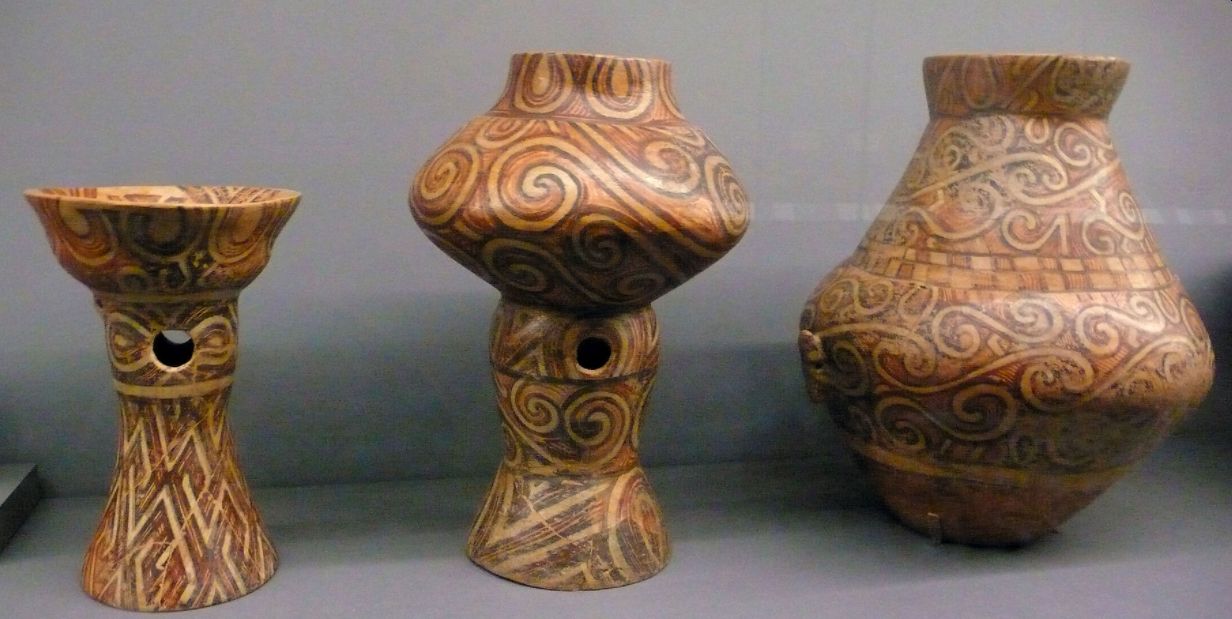
The Yangshao
Culture, which can be traced back to 4,900BC to 2,900BC, is a Neolithic culture
that existed extensively along the Yellow River in China. The culture
flourished mainly in what is today Northwest China's Shaanxi Province, North
China's Shanxi Province, and Central China's Henan Province.
Unearthed painted pottery from the Yangshao
Culture
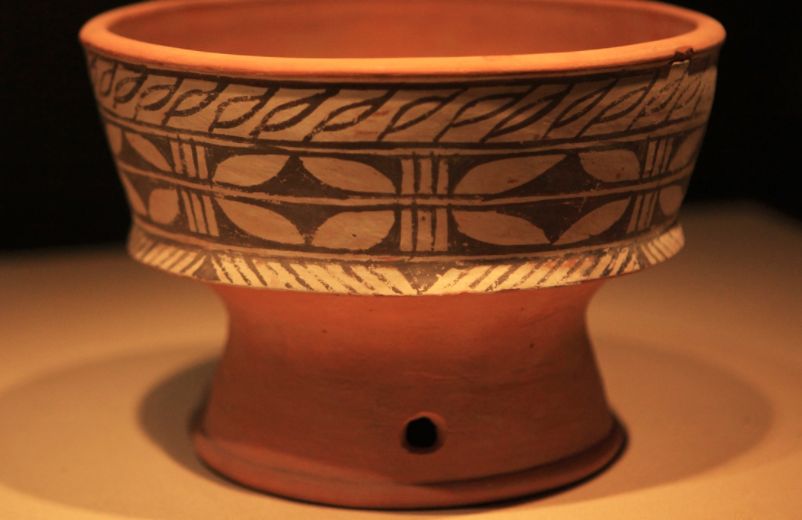
As we have seen in part one the problem is not merely
one of time but also of space. Astonishingly, some of the most striking
‘Neolithic’ leaps towards urban life are now known to have taken place in the
far north, on the frontier with Mongolia. From the perspective of later Chinese
empires (and the historians who described them), these regions were already
halfway to ‘nomad barbarian and would eventually go beyond the Great Wall.
Nobody expected archaeologists to find there, of all places, a 4,000-year-old
city, extending over 400 hectares, with a great stone wall enclosing palaces
and a step-pyramid, lording it over a subservient rural hinterland nearly 1,000
years pre-Shang.
At the site of Taosi –
contemporary with Shimao, but located far to the south in the Jinnan basin – we find a rather different story.
Between 2300 and 1800 BC, Taosi went
through three phases of expansion.
According to Chinese archaeologists, the
Yangshao Culture was the first integration of Chinese
prehistoric culture. And agreed that in the future, we might not limit Chinese
history to the Zhou, Qin, and Han dynasties (1046 BC-AD 220), but will trace it back
to the Yangshao era.
That indigenous doctrines of individual
liberty, mutual aid, and political equality, which made such an impression on
French Enlightenment thinkers, were neither (as many of them supposed) the way
all humans can be expected to behave in the State of Nature. Instead, certain
freedoms – to move, disobey, and rearrange social ties – tend to be taken for
granted by anyone who has not been trained explicitly into obedience (as anyone
reading this book, for instance, is likely to have been). Still, the societies that European settlers
encountered only really make sense as the product of a specific political
history: a history in which questions of hereditary power, revealed religion,
personal freedom, and the independence of women were still very much matters of
self-conscious debate.
Tianyuan Man, from near present-day Beijing, and Hòabìnhian people, from present-day Laos and Malaysia,
represent two very old lineages that are distinct from today’s East Asians.
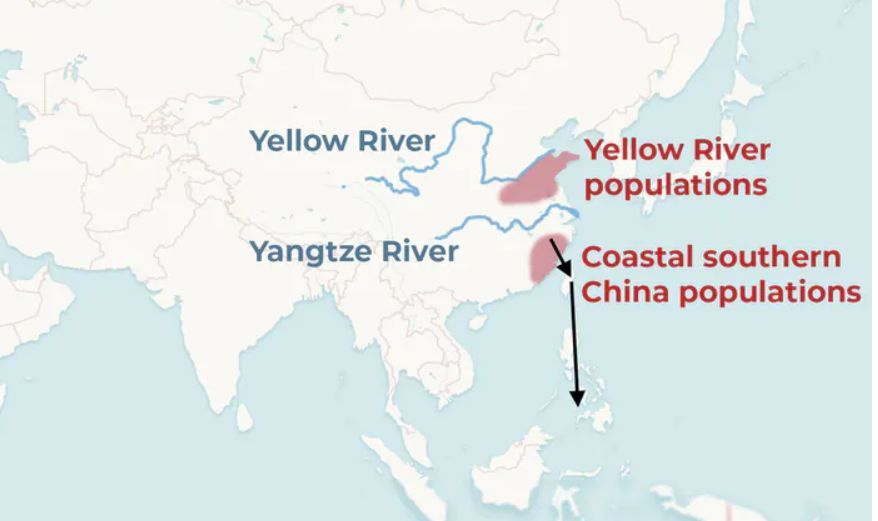
The sequences from ancient DNA were extracted from the leg bones of the Tianyuan Man,
a 40,000-year-old
individual, and
discovered near a famous paleoanthropological site in western Beijing. One of the earliest modern
humans found in East Asia, his genetic sequence marks him as an early ancestor
of today’s Asians and Native Americans. That he lived where China’s current
capital stands indicates that the ancestors of today’s Asians began placing
roots in East Asia as early as 40,000 years ago.
Farther south, two 8,000- to 4,000-year-old
Southeast Asian hunter-gatherers from Laos and Malaysia associated with the Hòabìnhian culture have DNA that, like the Tianyuan Man, shows they’re early ancestors of Asians and
Native Americans. These two came from a completely different lineage than the Tianyuan Man, which suggested that many genetically
distinct populations occupied Asia in the past.
But no humans today share the same genetic makeup as
either Hòabìnhians or the Tianyuan
Man, in both East and Southeast Asia. Why did ancestries that persisted for so
long vanish from the gene pool of people alive now? Ancient farmers carry the
key to that answer.
Rice farmers, possibly from around the Yangtze River,
moved south into Southeast Asia, while millet farmers from around the Yellow
River moved north into Siberia:
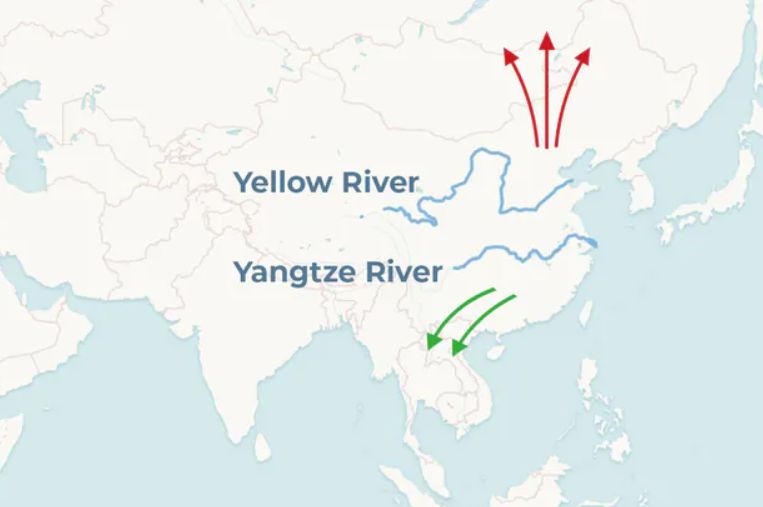
Based on plant remains found at archaeological sites,
scientists know that people
domesticated millet in northern
China’s Yellow River region about 10,000 years ago. Around the same time,
people in southern China’s Yangtze River region domesticated rice.
Because their archaeology and morphology was different from that of the Yellow River
farmers, we had thought these coastal people might come from a lineage not
closely related to those first agricultural East Asians. Maybe this group’s
ancestry would be similar to the Tianyuan Man or Hòabìnhians.
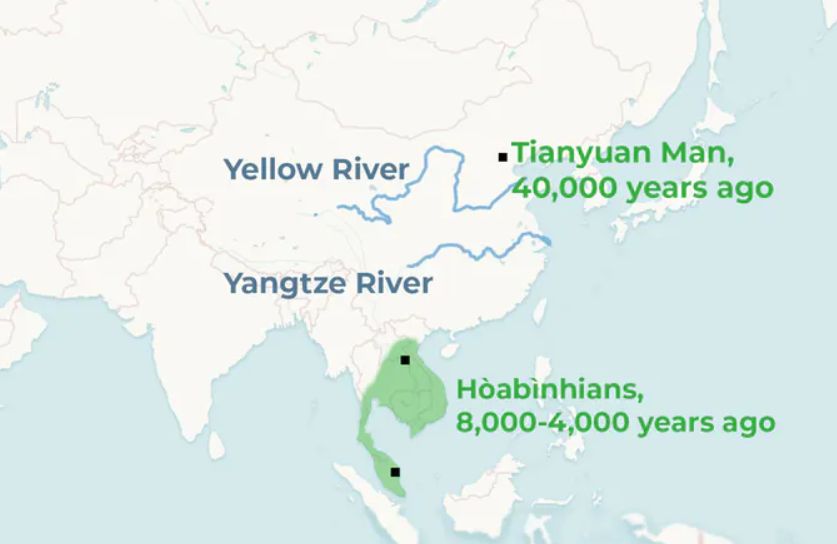
Today’s northern and southern Chinese populations
share more in common with ancient Yellow River populations than with ancient
coastal southern Chinese. Thus, early Yellow River farmers migrated both north
and south, contributing to the gene pool of humans across East and Southeast
Asia.
The coastal southern Chinese ancestry did not vanish,
though. It persisted in small amounts and did increase in northern China’s Yellow River region
over time. The influence of
ancient southern East Asians is low on the mainland, but they had a huge impact
elsewhere. On islands spanning from the Taiwan Strait to Polynesia live
the Austronesians, best known for their seafaring. They possess
the highest amount of southern East
Asian ancestry today,
highlighting their ancestry’s roots in coastal southern China.
Other emerging genetic patterns show connections between Tibetans and ancient
individuals from Mongolia and northern China, raising questions about the
peopling of the Tibetan Plateau.
Ancient DNA reveals rapid shifts in ancestry over the
last 10,000 years across Asia, likely due to migration and cultural exchange.
Until more ancient human DNA is retrieved, scientists can only speculate as to
exactly who, genetically speaking, lived in East Asia prior to that.
But what happened on land also span the oceans,
thus 3000 years ago that humans first set foot on Fiji and other isolated
islands of the Pacific, having sailed across thousands of kilometers of ocean.
Yet the identity of these intrepid seafarers has been lost to time. They left a
trail of distinctive red pottery but few other clues and scientists have
confronted two different scenarios: The explorers were either farmer who sailed
directly from mainland East Asia to the remote islands, or people who mixed with
hunter-gatherers they met along the way in Melanesia, including Papua New
Guinea.
Recently, the
first genome-wide study of ancient DNA from prehistoric Polynesians has
boosted the first idea: that these ancient mariners were East Asians who swept
out into the Pacific. It wasn't until much later that Melanesians, probably
men, ventured out into Oceania and mixed with the Polynesians.
And coming back to our
starting point as we have maintained from the beginning Anatolia was
home to some of the earliest farming communities. It has been long debated
whether the migration of farming groups introduced agriculture to central
Anatolia. Here, we report the first genome-wide data from a 15,000-year-old
Anatolian hunter-gatherer and from seven Anatolian and Levantine early farmers.
We find high genetic continuity (~80-90%) between the hunter-gatherers and
early farmers of Anatolia and detect two distinct incoming ancestries: an early
Iranian/Caucasus related one and a later one linked to the ancient Levant.
Finally, we observe a genetic link between southern Europe and the Near East
predating 15,000 years ago. Our results suggest
a limited role of human migration in the emergence of agriculture in central
Anatolia.
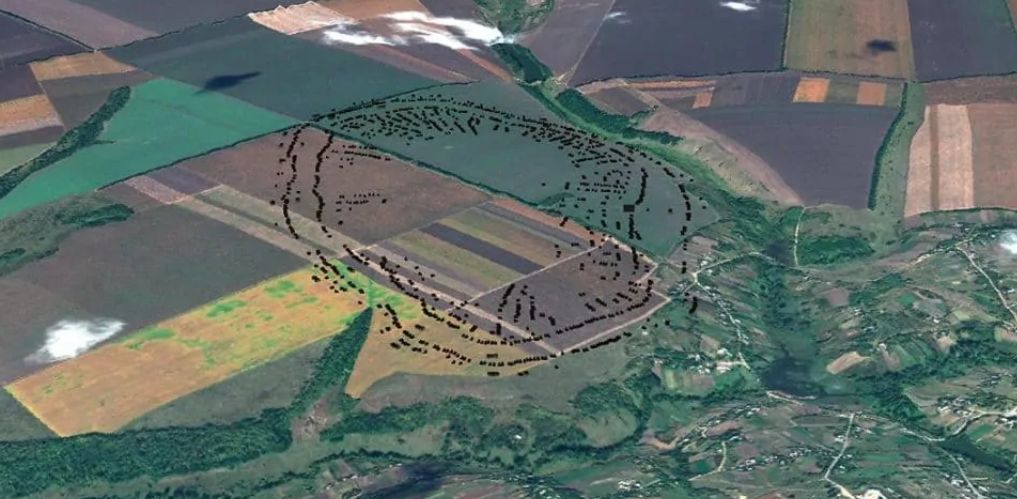
That indigenous doctrines of individual
liberty, mutual aid, and political equality, which made such an impression on
French Enlightenment thinkers, were neither (as many of them supposed) the way
all humans can be expected to behave in the State of Nature. Instead, certain
freedoms – to move, disobey, and rearrange social ties – tend to be taken for
granted by anyone who has not been trained explicitly into obedience (as anyone
reading this book, for instance, is likely to have been). Still, the societies that
European settlers encountered only really make sense as the product of a
specific political history: a history in which questions of hereditary power,
revealed religion, personal freedom, and the independence of women were still
very much matters of self-conscious debate.
Göbekli Tepe revisited part four will address
subjects like why and in what context did cave paintings (discovered
in late 2017) like the following pig appeared at least
45,500 years ago in what is now Sulawesi Indonesia. Whereby the suggestion
was that they are signs of those who first migrated down the
Indonesian island chain and onto the northern tip of Australia some 65,000
years ago.
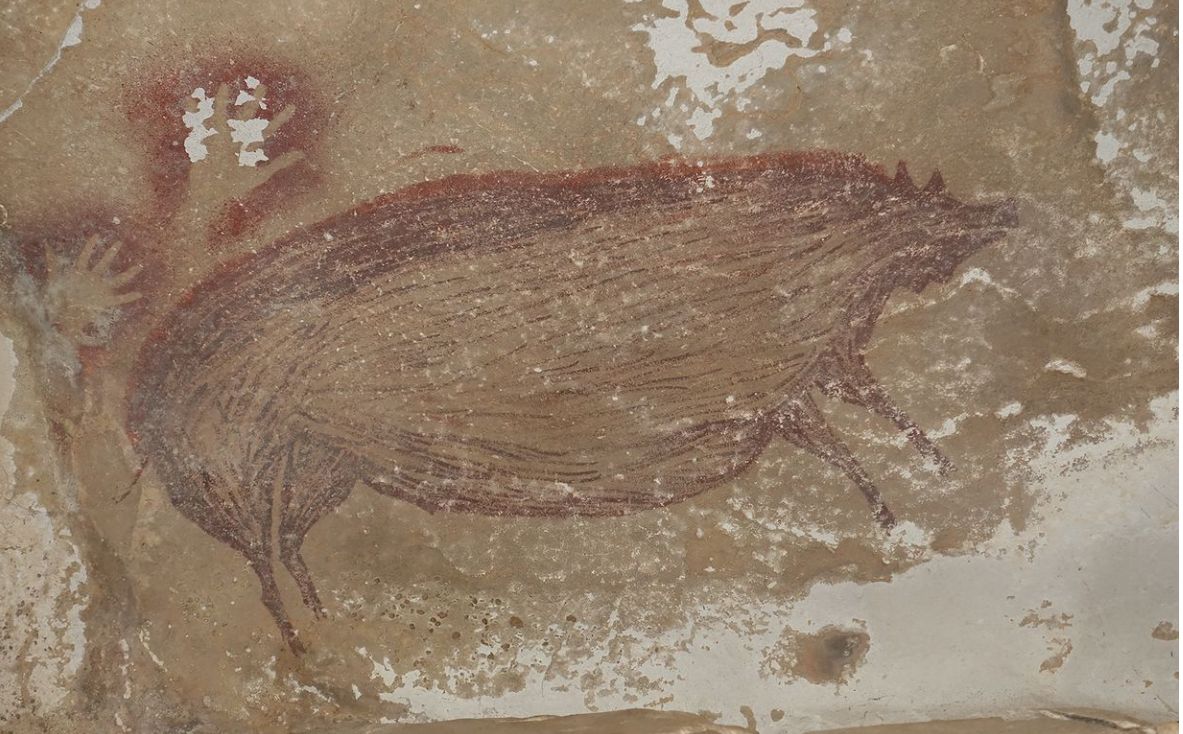
1. Dorian Q.Fuller,‘Contrasting
patterns in crop domestication and domestication rates: recent
2. For China see Anne P. Underhill
et al, ‘Changes in regional settlement patterns and the development of complex
societies in southeastern Shandong, China.’ Journal of Anthropological
Archaeology 27 (1),2008, 1–29; for Peru see RuthSolis,,
Jonathan Haas and Winifred Creamer. ‘Dating Caral, a Preceramic site in the
Supe Valley on the central coast of Peru.’ Science 292 (5517), 2001,
723–6.
3. On ‘Early Bronze Age urbanism and its
periphery’ in western Eurasia see Andrew. Sherratt, Economy and
Society in Prehistoric Europe. Changing Perspectives. Edinburgh: Edinburgh
University Press,1997, 457–70; and more generally, James C.Scott’s, Against the Grain: A Deep History of the
Earliest States. New Haven, CT and London: Yale University Press,2017, 219–56,
'reflections on ‘The golden age of the barbarians’.
4. This pattern much resembles Max Weber’s
famous notion of ‘the routinization of charisma, where the vision of a
‘religious virtuoso’, whose charismatic quality was based explicitly on
presenting a total break with traditional ideas and practices, is gradually
bureaucratized in subsequent generations. Weber argued that this was the key to
understanding the internal dynamics of religious change.
5. Kroeber (1944: 761) began his grand
conclusion as follows: ‘I see no evidence of any true law in the phenomena
dealt with; nothing cyclical, regularly repetitive, or necessary. There is
nothing to show either that every culture must develop patterns within which a
florescence of quality is possible, or that, having once so flowered, it must
wither without chance of revival.’ Neither did he find any necessary relation
between cultural achievement and systems of government.
6. In their additional cultic role as
the ‘god’s hand’ the wives of Amun – such as Amenirdis I and Shepenupet II – were also obliged to assist the male
creator-god in acts of cosmic masturbation; so, in ritual terms, she was as
subordinate to a male principal as one could possibly imagine, while in reality
running a good portion of Upper Egypt’s economy and calling political shots at
court. Judging by the grand locations of their funerary chapels at Karnak and Medinet Habu, the combination made for some very effective
realpolitik.
7. See John Taylor’s chapter on ‘The
Third Intermediate Period’ in Shaw (ed.) 2000: 330–69, especially 360–62.
8. Schneider 2008: 184. 37. In The
Oxford History of Ancient Egypt (Shaw ed. 2000), for instance, the relevant
chapter is called ‘Middle Kingdom Renaissance (c.2055–1650 BC).’
9. In The Oxford History of Ancient
Egypt (Shaw ed. 2000), for instance, the relevant chapter is called ‘Middle
Kingdom Renaissance (c.2055–1650 BC).
For updates click homepage here